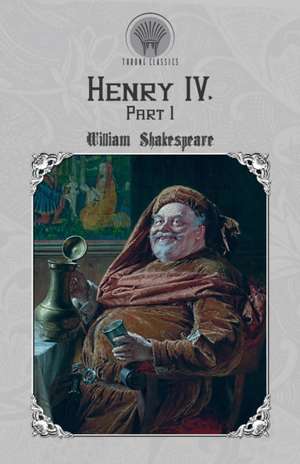Henry IV, Part 1
Autor William Shakespeareen Limba Engleză Paperback – 8 iul 2019
Henry IV, Part 1 is a history play by William Shakespeare, believed to have been written no later than 1597. It is the second of Shakespeare's tetralogy that deals with the successive reigns of Richard II, Henry IV (2 plays), and Henry V. Henry IV, Part 1 depicts a span of history that begins with Hotspur's battle at Homildon against the Douglas late in 1402 and ends with the defeat of the rebels at Shrewsbury in the middle of 1403. From the start it has been an extremely popular play both with the public and the critics.
| Toate formatele și edițiile | Preț | Express |
|---|---|---|
| Paperback (9) | 40.05 lei 3-5 săpt. | |
| CREATESPACE – | 40.05 lei 3-5 săpt. | |
| Penguin Random House Group – 6 apr 2017 | 46.73 lei 26-32 zile | +15.31 lei 7-13 zile |
| CreateSpace Independent Publishing Platform – | 48.05 lei 3-5 săpt. | |
| Modern Library – 31 iul 2009 | 75.68 lei 3-5 săpt. | |
| CREATESPACE – | 80.38 lei 3-5 săpt. | |
| CREATESPACE – | 81.68 lei 3-5 săpt. | |
| – | 98.44 lei 3-5 săpt. | |
| – | 54.26 lei 6-8 săpt. | |
| Throne Classics – 8 iul 2019 | 102.28 lei 38-44 zile | |
| Hardback (2) | 172.37 lei 38-44 zile | |
| Throne Classics – 8 iul 2019 | 172.37 lei 38-44 zile | |
| Prince Classics – 9 mai 2019 | 172.37 lei 38-44 zile |
Preț: 102.28 lei
Nou
Puncte Express: 153
Preț estimativ în valută:
19.57€ • 20.31$ • 16.36£
19.57€ • 20.31$ • 16.36£
Carte tipărită la comandă
Livrare economică 11-17 martie
Preluare comenzi: 021 569.72.76
Specificații
ISBN-13: 9789389369007
ISBN-10: 9389369002
Pagini: 188
Dimensiuni: 140 x 216 x 10 mm
Greutate: 0.25 kg
Editura: Throne Classics
ISBN-10: 9389369002
Pagini: 188
Dimensiuni: 140 x 216 x 10 mm
Greutate: 0.25 kg
Editura: Throne Classics
Descriere
Descriere de la o altă ediție sau format:
The repackaging of the acclaimed Pelican Shakespeare series continues with more dazzling new covers to excite Shakespearians of all ages
The repackaging of the acclaimed Pelican Shakespeare series continues with more dazzling new covers to excite Shakespearians of all ages
Notă biografică
William Shakespeare was born in Stratford-upon-Avon in April 1564, and his birth is traditionally celebrated on April 23. The facts of his life, known from surviving documents, are sparse. He was one of eight children born to John Shakespeare, a merchant of some standing in his community. William probably went to the King’s New School in Stratford, but he had no university education. In November 1582, at the age of eighteen, he married Anne Hathaway, eight years his senior, who was pregnant with their first child, Susanna. She was born on May 26, 1583. Twins, a boy, Hamnet ( who would die at age eleven), and a girl, Judith, were born in 1585. By 1592 Shakespeare had gone to London working as an actor and already known as a playwright. A rival dramatist, Robert Greene, referred to him as “an upstart crow, beautified with our feathers.” Shakespeare became a principal shareholder and playwright of the successful acting troupe, the Lord Chamberlain’s Men (later under James I, called the King’s Men). In 1599 the Lord Chamberlain’s Men built and occupied the Globe Theater in Southwark near the Thames River. Here many of Shakespeare’s plays were performed by the most famous actors of his time, including Richard Burbage, Will Kempe, and Robert Armin. In addition to his 37 plays, Shakespeare had a hand in others, including Sir Thomas More and The Two Noble Kinsmen, and he wrote poems, including Venus and Adonis and The Rape of Lucrece. His 154 sonnets were published, probably without his authorization, in 1609. In 1611 or 1612 he gave up his lodgings in London and devoted more and more time to retirement in Stratford, though he continued writing such plays as The Tempest and Henry VII until about 1613. He died on April 23 1616, and was buried in Holy Trinity Church, Stratford. No collected edition of his plays was published during his life-time, but in 1623 two members of his acting company, John Heminges and Henry Condell, put together the great collection now called the First Folio.









